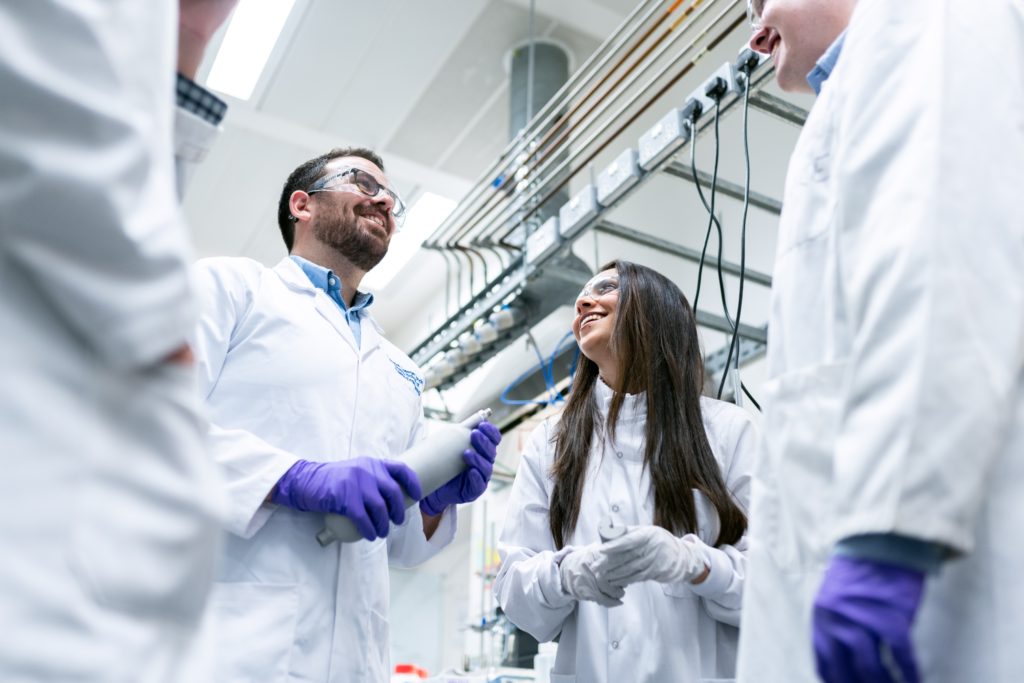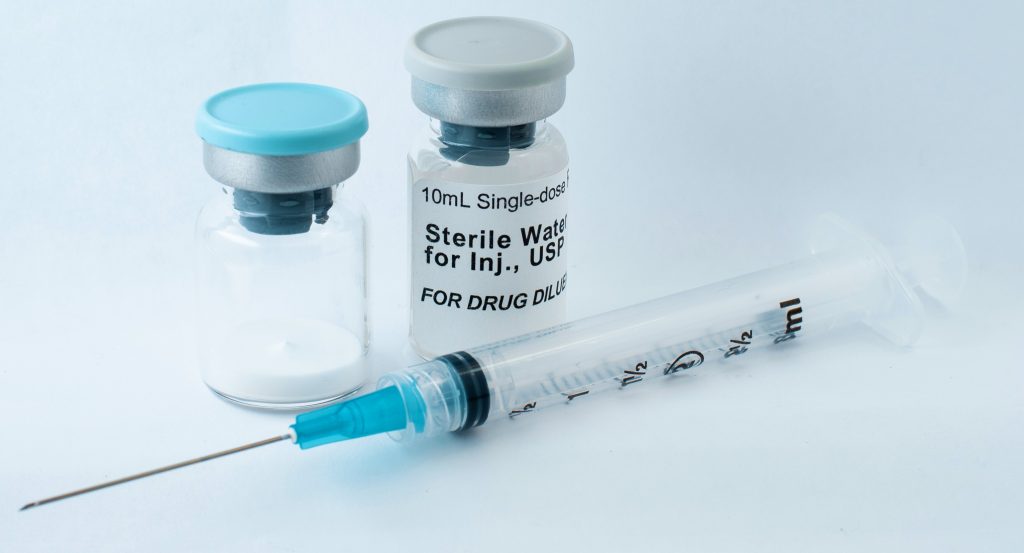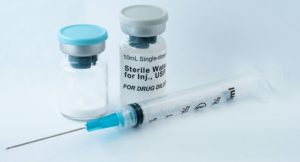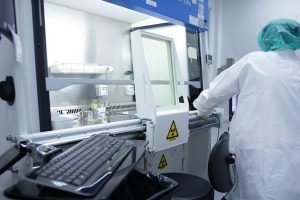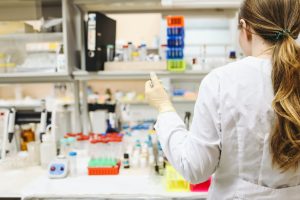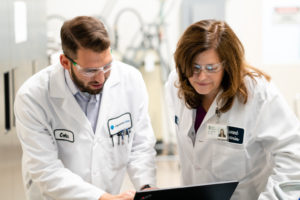Category Archives: Services
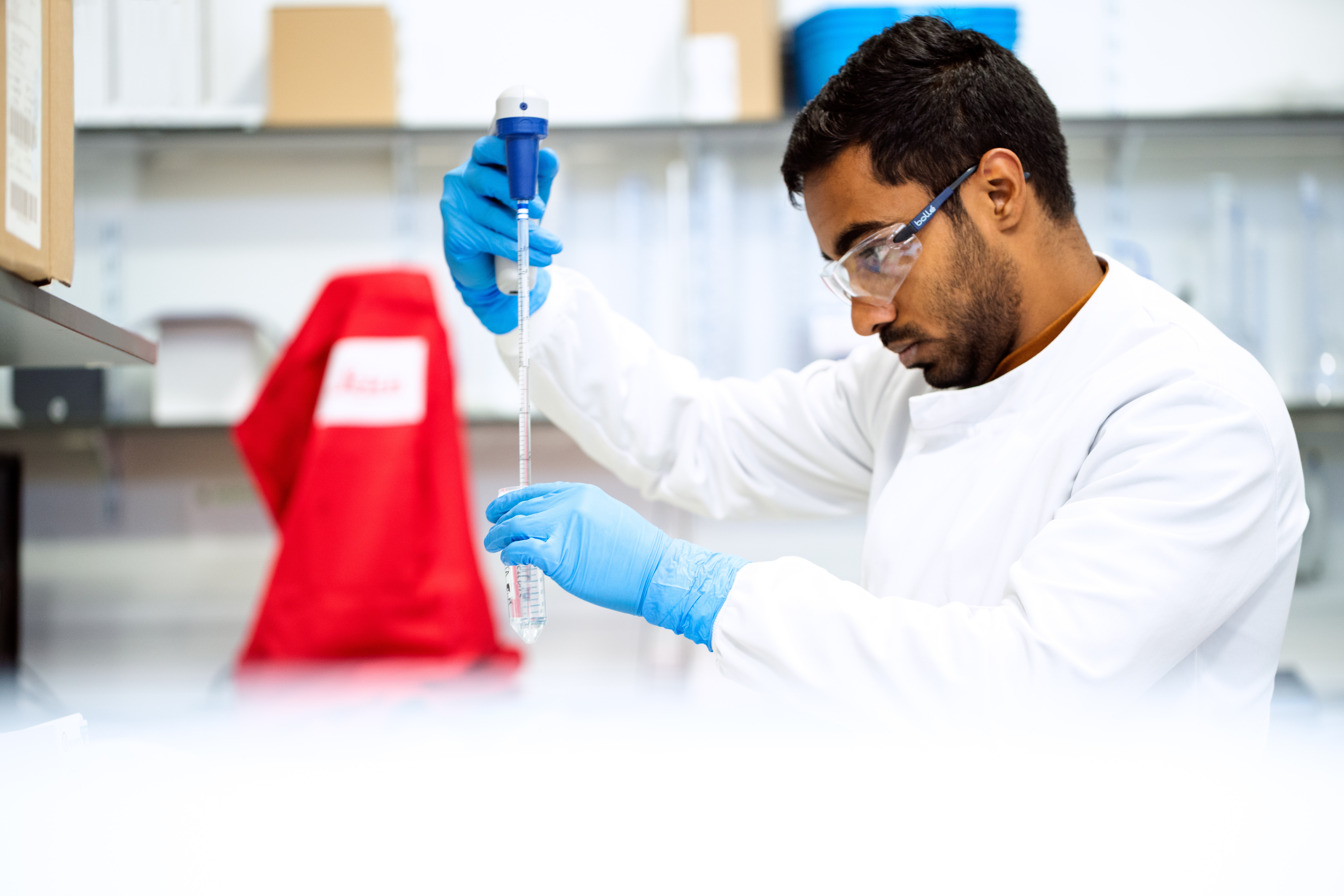
At Oakwood Labs, we’re proud to contribute to the development of cancer pharmaceuticals through our continuous work manufacturing long-acting injectables (LAIs). That’s why we’ve compiled an informational guide showcasing our ongoing work in the healthcare field, as well as the numerous benefits of LAIs for oncology treatment.
Advantages of Long-Acting Injectables to Treat Cancer
There are numerous advantages to the use of LAIs as pharmaceuticals to treat cancer. To start, Bruton tyrosine kinase (BTK) inhibitors are established standards of care in multiple B-cell malignancies including chronic lymphocytic leukemia, mantle cell lymphoma, and Waldenstrom macroglobulinemia. LAI formulations of BTK inhibitors offer certain advantages in terms of pharmacokinetics (PK) and patient adherence. For example, ibrutinib (Imbruvica) has a very short half-life of 4-6 hours. Hence, relatively large doses of the oral form are required to target plasma levels within the therapeutic range.
The PK profile is marked by large peaks and valleys, sometimes exceeding the therapeutic level, and sometimes falling below. The PK profile of the LAI formulation is much “smoother,” having no significant peaks and valleys. Also, the oral bioavailability of ibrutinib is only 3% and varies among patients. The LAI formulation, meanwhile, is 100% bioavailable and therefore can be administered at much lower per-day doses.
These factors above could reduce side effects caused by off-target receptor interactions, while maintaining efficacy, and result in fewer cases in which the medication needs to be discontinued. The LAI formulations of two weeks and one month ensure patient adherence for these periods, possibly enhancing efficacy in clinical practice.
Similar benefits may be possible with other immunomodulatory cancer pharmaceuticals, such as the thalidomide analog pomalidomide (Pomalyst), indicated for multiple myeloma. The recommended dose for multiple myeloma is 4 mg per day taken orally on days 1 through 21 of repeated 28-day cycles. The half-life is approximately 7.5 hours and oral bioavailability is estimated to be approximately 75%. The LAI formulation reduces the peaks and valleys of drug exposure, enables a reduction in the total amount of drug administered, reduces the frequency of doses, possibly reduces side effects, and ensures patient adherence.
Additional Benefits to Highlight
Along with administration approaches and the long-term effects on the body, LAIs as oncology pharmaceuticals possess several key advantages for the patient, including:
- Reduced treatment burden
- Increased patient compliance
- Sustained stable hormone suppression
How Oakwood Labs Is Contributing to Cancer Drug Development
Alongside working with external partners who have been seeking out LAIs for their own initiatives, our team is also currently in the process of creating internal programs that utilize our very own microparticle technology. The goal of these internal initiatives is to convert an existing product into an LAI formulation to extend the duration of drug release to what is currently on the market, achieving patient compliance and ease of use.
More specifically, Oakwood Labs has used its internal technology to progress its formulations that are focused on treating mantle cell lymphoma, small lymphocytic lymphoma, chronic lymphocytic leukemia, and multiple myeloma with release durations ranging anywhere between two and four weeks. Our LAI oncology drug development has led to significant benefits for patients, such as:
- Reducing the amount of drug administered to the patient
- Decreasing the number of doses needing to be injected
- Diminishing more adverse reactions and side effects from dosages
Partnership Opportunities
At this point in the cancer drug development process, our team is actively seeking an external partner to help further develop our internal program. Key responsibilities in this area include funding ongoing development activities as well as phases one through three of clinical trials and registration/commercialization efforts.
If you’re interested in learning more about this opportunity, please contact our team directly, as we would be happy to provide additional details or answer any questions you may have.
FAQs About Oncology Pharmaceuticals, Development, and More
Can you provide me a brief history of oncology pharmaceutical development and its breakthroughs?
Though it is estimated that the preliminary study and treatment of cancer was initially recorded as early as 520 BCE when Persian queen Atossa was treated for a breast tumor, modern-day pharmaceuticals for treating cancer did not surface until relatively recently. Just some of the pivotal findings in this scientific journey include:
- The 1840s – Physician Rudolf Virchow is well-known for his observation of cancer cells during this time, in which he defined their key characteristics. This led to the future of cancer treatment protocols by the start of the 20th
- 1895 – Once German physicist Wilhelm Conrad Röntgen first correctly identified the waves of radiation that we all now know as X-rays, this equipment was then used in radiotherapy cancer treatment shortly thereafter.
- The 1940s – Based on the discovery that nitrogen mustard contains anticancer properties during World War II, researchers were able to develop various cytotoxic drugs to directly target dividing cancer cells, which later led to today’s chemotherapy practices.
Can you tell me more about the work Oakwood Labs does to develop LAIs?
Oakwood Labs performs LAI development through our technology platform Chroniject™, and some characteristics of products we have made with this system including the following:
- The duration of release is one week to one year
- LAIs are easily syringable with 18- to 23-gauge needles
- Products are reconstituted immediately with sterile water
- LAIs are filled aseptically and terminally sterilized if feasible
- Products have proven content uniformity and good stability characteristics
- LAIs are free of foreign particulate matter
Additionally, Chroniject™ is microsphere-based and has biodegradable polymers such as PLA, PLGA, and other polymers with demonstrated low toxicity and sourced from multiple suppliers. Plus, the finished dosage form typically consists of a lyophilized vial containing microspheres, a suspending agent, and other excipients.
What are the current barriers to an LAI entering this particular space?
The barrier to entry is that LAI formulations are extremely difficult to develop and require a high degree of technical expertise. Once developed, you then need to scale up the process to be able to manufacture in an aseptic GMP facility. The Oakwood Labs team can work with you to overcome key challenges.
What are some common trends in the development of drugs to treat cancer?
As healthcare professionals and pharmaceutical developers continue to produce different types of drugs for treating cancer, numerous trends have emerged from their discoveries, such as:
- Targeted drugs for treatment
- Immunotherapy
- Monoclonal antibodies
- Small molecule-targeted agents
- CRISPR
- Biomaterials, such as chitosan oligosaccharide (COS)
These recent practices have significantly advanced the oncology field, leading to longer, happier, and healthier lives for patients undergoing treatment.
Contact Oakwood Labs for More Information
If you have any additional questions about the oncology drug development process, or if you’re looking to get in touch with us regarding a potential partnership opportunity, please contact our team today. We look forward to assisting you.
Different health conditions and disorders can require a range of tactics for successful treatment, and mental and emotional issues patients face are no exception. Conditions such as depression, schizophrenia, bipolar disorder, and more require reliable medications paired with other forms of therapy to elicit the best results, which is where the team at Oakwood Labs comes in.
We’re adept at developing long-acting injectables for treating major depressive disorder and other conditions, and we’ve successfully manufactured and scaled up formulations for diverse clients. Read on to learn about our depression pharmaceutical development and other key services.
A Brief History of Depression Pharmaceutical Development
The age of modern antidepressant drugs began in the early 1950s when researchers who were attempting to cure tuberculosis instead noticed that two of the chemicals found in their test batch compounds – isoniazid and iproniazid – improved the mental states of test subjects.
Research continued until the initial phase of depression pharmaceutical development was under way, leading to tricyclic antidepressants and monoamine oxidase inhibitors. Though a step forward for the greater cause, side effects these drugs produced were troublesome, leading to more research and development being necessary in the field. Despite some of their associated issues, drugs of these type are still prescribed in some cases.
The second phase of research focused on key neurotransmitters and divided medication into the categories of selective serotonin reuptake inhibitors and norepinephrine reuptake inhibitors. SSRIs tended to be much safer than the previous drugs on the market, though they were not always as effective, leading to the development of SNRIs, which covered a larger selection of neurotransmitters.
All of the drugs that fell under these classifications traditionally were administered through the means of oral medication, though that is changing in the modern era. The viability of utilizing injectables for treating depression is becoming more recognized, paving the way for new treatments and advancements.
Our Process for Developing Long-Acting Injectables to Treat Major Depressive Disorder
At Oakwood Labs, when it comes to creating long-acting injectables for depression, schizophrenia, bipolar disorder, and other conditions, we stand out as being one of the few independent companies that can develop these products from concept to FDA approval.
Our facilities utilize proven technology that has shown scalability from 5-10 g starting batch size to 32 kg commercial batch size, and we also have the ability to manufacture our products aseptically within our own GMP facility.
When it comes to injectables for treating depression, Oakwood Labs partners with organizations to work on external projects, and we also have an extensive internal development project pipeline within the CNS space. We are actively looking to partner with organizations, so if you have a project in mind be sure to contact us.
How We Overcome Difficulties
One barrier for using long-acting injectables to treat major depressive disorder is the difficulty in formulating and manufacturing these drugs aseptically. In order to develop and commercialize a product, you need specialized drug delivery technology and an effective process, such as the one used at Oakwood Labs.
Our process allows for a customized release profile for every product, and the ability to scale up that formulation for a commercial batch size.
Benefits of Shifting from Oral Medications to Long-Acting Injectables to Treat Depression
One of the primary advantages to making this change is patient compliance, as patients who suffer from schizophrenia, depression, bipolar disorder and other conditions sometimes do not want to take a prescribed drug, or they forget to. That is why many schizophrenia drugs, for instance, are now available in both oral and long-acting injectable forms.
Other major benefits of using long-acting injectables include:
- Reducing the number of required injections
- Being able to target specific anatomical areas
- Helping to prevent drug abuse
All of these aspects can help contribute to better care, assisting facilities and doctors in providing the best for their patients.
Our Services Beyond Depression Pharmaceutical Development
When you choose to partner with Oakwood Labs, you’ll be working with a global leader in sustained-release drug delivery who can supply a range of services. Some of our offerings beyond injectables for treating depression include:
- Microsphere formulation development
- Formulation optimization and scale-up
- Analytical method development
- GMP aseptic manufacturing
- Contract manufacturing
Please review specifics about each service on their respective pages, and get in touch with us if you are interested in beginning a project.
Contact Oakwood Labs Today
If you’re looking to partner with an experienced team to produce long-acting injectables for major depressive disorder and other conditions, Oakwood Labs is your resource. Get in touch with us and we’ll help you determine a plan of action.
When developing and manufacturing a new drug, the list of requirements can get extensive. With the needs for drug discovery, development research, review, and production, there are a lot of moving parts to ensure that a product is safe for patients once it hits the market.
Due to this, assistance for the different phases of pharmaceutical drug development is often sought out, and these support companies come in the form of CDMOs, CROs, and CMOs, organizations that serve the pharmaceutical and biotechnology industries. Learn more about the differences between these organizations in our post so you can determine which will be the most beneficial during your pharmaceutical development process.
CRO vs. CMO vs. CDMO
Let’s explore the distinctions between the three types of organizations that can aid you in your pharmaceutical processes.
Contract Research Organization
A Contract Research Organization, or a CRO, is a destination for research, including clinical trial management, preclinical research, data management, regulatory affairs, and post-marketing surveillance. These organizations focus mostly on research and development services, including clinical trials and regulatory compliance. This means they are involved mostly in the early stages of drug development and play a major role in the overall research and regulatory aspects of drug development.
CROs largely support pharmaceutical companies in research and regulations. Outsourcing to a CRO allows the pharmaceutical company to focus on building other areas of the business and prioritizing other tasks.
Contract Manufacturing Organization
A Contract Manufacturing Organization, or a CMO, specializes in the production of pharmaceuticals and all things related to manufacturing. CMOs are adept at handling large-scale production once the drug has been developed. Their services are beneficial because they utilize cutting-edge technology and have skilled employees who bring expertise to the development process.
Working with a CMO also ensures that the final product is compliant with both quality and regulatory standards, which allows the pharmaceutical company to focus on other things like drug discovery and marketing.
Contract Development Manufacturing Organization
A Contract Development and Manufacturing Organization, or a CDMO, offers a full range of services, from drug development through manufacturing. With operations in place for process development, scale-up, clinical trials, material production, and manufacturing, a CDMO is your end-to-end partner.
Because they are involved throughout the ensure lifecycle of drug development and manufacturing, CDMO facilities help pharmaceutical companies to reduce costs, accelerate time to market, and ensure regulatory standards are adhered to. Consult a CDMO to bridge the gap between development and manufacturing and achieve the most comprehensive solution.
Which Partner Is Best for You?
When deciding which organization to work with, be sure to analyze your company’s needs and challenges. If you are seeking a partner for clinical research support, a CRO is your answer. When you need manufacturing help, a CMO is going to be an ideal match. And if you want to outsource the entire process and ensure everything goes smoothly, a full-service CDMO is going to provide comprehensive and integrated development, support, and manufacturing. When you are looking for a reliable CMO or CDMO partner, Oakwood Labs is here to help.
At Oakwood Labs, we offer CDMO and CMO services for your convenience, and our team has over 25 years of experience with developing and manufacturing injectables for the pharmaceutical industry. We specialize in sustained-release and targeted-release injectables for long-term therapeutic relief. Along with this, our facility follows GMP aseptic manufacturing processes to provide FDA-approved pharmaceuticals to our clients.
Learn More About Our Abilities as Your Pharmaceutical Partner
Please contact us today to learn more about everything we can provide as your CMO or CDMO partner. We look forward to assisting you.
Oakwood Labs is a global leader in sustained-release drug delivery. Our facility provides feasibility studies, analytical development, scale-up capabilities, GMP clinical trial material, GMP contract manufacturing, and sterile fill-finish.
Sterile fill-finish is the final leg of the pharmaceutical manufacturing process, where a substance is filled into vials, ampoules, or other containers deemed appropriate. After the substance is put into containers, it is ready to be sent out for distribution. Learn more about our capabilities for this part of the process below.
The Process for Fill-Finish Pharmaceuticals
There are a variety of reasons that sterile fill-finish is essential in the manufacturing of long-acting injectables. Patient safety is at the top of the list, however, as the approach ensures that the product is free from microbial contamination.
What the Process Entails
When you begin the sterile fill-finish step, you are almost at the end of the drug manufacturing process. However, this is a critical point of the overall manufacturing process because it needs to be done correctly to ensure that your drug is safe for patients. At this point, you’ll want to request help from a fill-finish CDMO who can oversee the process properly.
Some of the steps that will be completed will include:
- Filling – In the filling process, the drug is placed into the final product containers under controlled and sterile conditions. Finish and fill services must be completed in a sterile environment to prevent contamination. For this reason, these services are performed in a cleanroom that has controlled air quality, temperature, and humidity. Additionally, it is important to ensure that sterile filling techniques are also applied to equipment and packaging.
- Container closure – It is important to select the appropriate container closer that is going to maintain the sterility and stability of the drug. Whether this is a vial, syringe, ampoule, or something else, the team you work with will help find the right solution for your application.
- Quality control – In the process of fill-finish for pharmaceuticals, rigorous quality control is practiced to ensure that the product meets regulations. Not only is the product tested throughout the process, but it also undergoes environmental monitoring and final product review to ensure that it is sterile and potent, and that it meets all other criteria that is required.
- Labeling and packaging – Once the product is filled, the finished item is labeled and packaged according to regulations and any requirements provided by outside sources.
- Regulation compliance check – It is important for aseptic, CDMO facilities to adhere to regulatory guidelines like Good Manufacturing Practice (GMP). This helps to ensure safety, efficacy, and quality, completing the final steps of the finish and fill process.
When you choose to work with a fill-finish CDMO, you can also receive different batch sizes to meet your project’s needs. From small-scale clinical trials to large-scale commercial production, our processes can be adapted to your specifications.
Let Oakwood Labs Be Your Fill-Finish CDMO
Oakwood Labs operates a fully compliant aseptic GMP facility. Our FDA-approved facility is headquartered near Cleveland, Ohio and centers on the development and manufacturing of sustained-release injectables for the pharmaceutical industry. We focus on creating pharmaceutical products that provide therapeutic benefits to our patients and excellent returns for our partners.
Whether you need assistance with fill-finish pharmaceutical services or something else, we are here to help. Other services we provide include:
- Formulation and analytical development activities
- Accelerated and long-term stability studies
- Scale-up, validation, or engineering batches
- Complete method transfer and validation
- Batch record and protocol development
Consult Our Finish and Fill Services Today!
If you are in need of pharmaceutical manufacturing, partner with Oakwood Labs to receive reliable and efficient services.
Contact us today to learn how you can achieve a sterile fill-finish with our CDMO.
Oakwood Labs has remained a reliable provider of pharmaceutical contract manufacturing services for more than twenty-five years. As a specialty pharmaceutical company, we are focused on two main areas. The first is our CDMO business which is concerned with the development and manufacture of sustained-release injectable pharmaceuticals through the use of our microsphere-based drug delivery technology. The second is our CMO business which focuses on manufacturing sterile injectable products for clinical, registration, and commercial needs.
Our team supports the manufacturing of sterile injectables to provide enhanced therapeutic benefits to patients in addition to excellent returns to our pharmaceutical partners. Sterile injectables continue to grow within the pharmaceutical industry and are expected to be produced to standards of safety, purity, and quality. Learn more about sterile injectable development at Oakwood Labs below.
Features of Oakwood’s Facility for Manufacturing Sterile Injectables
A full service CMO is valuable within the pharmaceutical industry due to its ability to provide aseptic pharmaceutical manufacturing and fill-finish capabilities. Sterile injectable products are an essential part of the global healthcare system. They are used to treat a wide range of conditions, from life-threatening diseases such as cancer or HIV/AIDS to chronic conditions such as diabetes and multiple sclerosis, and many others.
Also, aseptic manufacturing is essential because it minimizes the risk of introducing bacteria and contaminants that can enter the body when administering the medication.
In order to enhance our partnering and sterile injectable development capabilities, Oakwood Labs maintains an aseptic, FDA-approved manufacturing facility, ideal for manufacturing sterile injectables. This facility is equipped with the following beneficial features:
- Non-aseptic formulation
- Vial capping
- Compact and portable equipment train
- Aseptic filling
- Aseptic formulation
- Inspecting, labeling, and packaging
- Raw material dispensing and weighing
- Shipping, receiving, and warehouse space
- In-house QC microbiology and QC chemistry
- Equipment prep and staging
- Aseptic lyophilization
Our pristine full-service facility is just one of the many reasons that Oakwood Labs is an effective CMO partner. Since 1997, we have been achieving milestones within set deadlines, providing transparent communication, adapting to change, and offering our expertise throughout the process.
Choose Oakwood Labs for Your Sterile Injectable Needs
Oakwood Labs has been an effective partner to a great deal of pharmaceutical firms of various sizes across the globe. When you choose to partner with our GMP manufacturing facility, you are guaranteed to receive short lead times, robust quality systems, and CMC development capabilities for a broad range of sterile injectables and assorted products.
Oakwood Labs is fiercely committed to quality and has had a long history of compliance. Our Quality System ensures that sterile injectables manufactured at our facility comply with specified requirements and are safe, pure, and effective throughout the entirety of the product lifecycle.
When it comes to manufacturing sterile injectables, there is no better choice than Oakwood Labs. Choose us to be your reliable and dedicated partner.
Oakwood Labs Offers Pharmaceutical Contract Manufacturing Capabilities and Other Services
At Oakwood Labs, we support all phases of long-acting injectable (LAI) development. We pride ourselves on being a full-service cGMP manufacturing facility capable of providing services to our partners. The range of manufacturing services we offer includes:
- Small-volume sterile injectables
- Sterile liquids, sterile lyophilized parenteral, suspensions, microspheres, and more
- Class III and IV controlled substances
- Vials with lyophilized or plug stoppers (13mm and 20mm openings)
- Phase I, Phase II, or Phase III clinical trial material
- Commercial product to be utilized in humans or for veterinary use
In addition to the variety of GMP pharmaceutical manufacturing capabilities, Oakwood Labs also supplies other services including the following:
- Formulation and analytical development activities
- Accelerated and long-term stability studies
- Scale-up, validation, or engineering batches
- Complete method transfer and validation
- Batch record and protocol development
Not sure which of our services is best suited for your industry needs? Reach out to our team of experts today!
Our GMP Aseptic Manufacturing Capabilities
Sterile injections are made possible with procedural measures that prevent contamination, like Good Manufacturing Practices and an aseptic facility. An FDA-approved cGMP aseptic facility for sterile injectables has the ability to support clinical, registration, and commercial batches. We also host short- and long-term stability studies, which help you to achieve the perfect formulation.
Our in-house experience and expertise include method development, qualification, and validation support, as well as robust quality systems. Our team also has aseptic fill and finish capabilities, which means that we can create aqueous, solvent-based suspensions, as well as liquid and lyophilized presentations. The fill volume range is between 1 mL and 30 mL and the vial size range is between 2 cc and 30 cc.
These capabilities allow us to provide value to each partner we work with. If you are looking for a team that will deliver fast turnaround times, expertise in complex processes, assistance in technology transfer, and a high level of FDA quality standards, Oakwood Labs is your destination.
What are the current Good Manufacturing Process standards set by the FDA?
cGMP standards state that a pharmaceutical manufacturer must:
- Have a separate, classified, and clean area for production
- Filter and properly circulate air
- Maintain and sterilize all containers and closures
- Train and monitor all personnel involved with the process
- Wear sterile clothes
- Set time limits for different steps of the process
- Simulate and record the manufacturing process
Answering Your Frequently Asked Questions About Sterile Injectables
What technology is used during manufacturing to create sterile injectables?
Sterile processing equipment is necessary for pharmaceutical production and is essential for satisfying regulatory requirements. Therefore, it is common to see autoclaves, electro-steam generators, and washer-disinfectors in the pharmaceutical manufacturing process.
What are the common routes of administration for sterile injections?
There are four common methods of administration:
- Intravenous
- Intramuscular
- Subcutaneous
- Intradermal
Since injectables bypass the natural barriers of the body, it is essential for them to be sterile to reduce the risk of injections or complications in patients.
What is involved when testing sterile injectables for sterility?
According to the WHO, a pharmaceutical container is defined as sterile when the probability that it is contaminated with replicating microorganisms is less than one out of one million.
Sterility testing often involves the following:
- Biological indicators – Using microorganisms to test for the effectiveness of the sterilization
- Sterility tests – Culturing samples to check for microbial growth
- Endotoxin testing – Ensuring the product is free from pyrogens that cause fever
Since not every container can be opened, random samples are taken and tested to represent an entire batch.
How do sterile injectable drugs get packaged?
Depending on the needs of the patients and facility, sterile injectables can be put into:
- Ampoules – Sealed glass containers that are used once
- Vials – Glass or plastic containers that can be used once or for multiple doses
- Prefilled syringes – Packaged in ready-to-use doses that reduce preparation time and contamination risk
- Cartridges – Units commonly used for insulin
Contact Oakwood Labs to Learn More About Our Sterile Injectable Development
Are you looking for sterile injectables from a reliable company with decades of experience? Oakwood Labs has the solutions for you. Our team will work closely with you through proof of concept, feasibility studies, clinical trial material, and, ultimately, FDA-approved commercial supply.
Questions on our sterile injectable development? Contact Oakwood Labs today to learn more about how we can help. We look forward to assisting you!
Since 1997, Oakwood Labs has remained a global industry leader in sustained release pharmaceutical development and technology, and our team is committed to offering contract development and manufacturing services to the pharmaceutical industry on a global scale. Continue reading to learn more about our sustained release technology and the many ways it is beneficial in pharmaceuticals.
Oakwood Labs is a leading company in the development and manufacture of sustained release pharmaceutical products, specifically microparticles for injection. We specialize in developing microparticle drug delivery formulations with in vivo release durations ranging from one week to one year. To learn more about our process for formulation, keep reading.
Oakwood Labs has been working as a contract development and manufacturing company, or CDMO, for over twenty years, and we have remained a leader in the pharmaceutical industry in this time.
With our microsphere-based drug delivery technology and our cGMP manufacturing facility, we are equipped to provide services from initial feasibility through commercial projection. Our technology allows for ease of scale-up throughout development without impacting finished product results. We can customize release durations from weeks up to one year.




